New study finds that Star Trek's 'Vulcan' Planet does not exist
A real-life planet - similar to Star Trek's "Vulcan" - believed to orbit the star 40 Eridani A does not exist, a new study says.

Scientists have found that the signals believed to have emitted the presence of an undiscovered planet circling a star known as 40 Eridani A does not exist after all.
In its study published at The Astronomical Journal, researchers found that the planet revolving around a star, associated with the fictional planet Vulcan in the Star Trek Series, were false positives.
Further studies has shown that the signals most likely originate from the star itself.
- Incredible £13.2bn tunnel that connects two beautiful cities 168 miles apart
- Huge space breakthrough as new Earth-sized planet discovered
This comes after the real-life Vulcan planet was discovered in 2018, and it was designated as 40 Eridani A b, or HD 26965 b.

The detection of the planet's signal was conducted by the use of radial velocity, a technique employed when the planet's orbit does not intersect our line of sight with the star.
This was not the first time that research determined that a real-life Vulcan planet did not exist.
In 2021, a study concluded that the signal was deemed to be false positive, and in 2022, another study found the results inconclusive. A third study in 2023 also found a false positive signal.
The identification of Vulcan as Spock's home planet debuted in the original television series of the 1960s.
In the 2009 film "Star Trek," a Romulan antagonist called Nero utilizes an artificial black hole to obliterate Spock's home planet.
The radial velocity data in this study, however, offers the possibility to establish more precise observational differences between real planets and the vibrations of stars.
